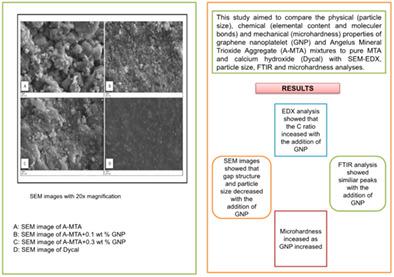当前位置:
X-MOL 学术
›
Microsc. Res. Tech.
›
论文详情
Our official English website, www.x-mol.net, welcomes your feedback! (Note: you will need to create a separate account there.)
In vitro comparison of physical, chemical, and mechanical properties of graphene nanoplatelet added Angelus mineral trioxide aggregate to pure Angelus mineral trioxide aggregate and calcium hydroxide
Microscopy Research and Technique ( IF 2.5 ) Pub Date : 2021-01-07 , DOI: 10.1002/jemt.23654 Elif Nihan Kucukyildiz 1 , Burak Dayi 1 , Serdar Altin 2 , Oktay Yigit 3
Microscopy Research and Technique ( IF 2.5 ) Pub Date : 2021-01-07 , DOI: 10.1002/jemt.23654 Elif Nihan Kucukyildiz 1 , Burak Dayi 1 , Serdar Altin 2 , Oktay Yigit 3
Affiliation

|
It is important to cover the pulp surface with a biocompatible material that is physically, mechanically, and chemically adequate. Graphene has the potential to form hard tissue, but at high doses, it shows toxic effects. It can be added to biocompatible materials at low doses to enhance their hard tissue forming potential. The aim of this study was to compare the physical, chemical, and mechanical properties of graphene nanoplatelet (GNP) added Angelus mineral trioxide aggregate (A‐MTA) to pure A‐MTA and calcium hydroxide. Homogeneous mixtures (created by adding +0.1 weight[wt]% and 0.3 wt% GNP to A‐MTA), pure A‐MTA, and Dycal were used. Three disc‐shaped samples of each material were prepared using Teflon mold. Scanning electron microscope–energy dispersive X‐ray (SEM–EDX), particle size, microhardness, and Fourier transform infrared spectroscopy (FTIR) analysis of the materials were performed in vitro. Data were analyzed using Kruskal–Wallis test followed by Conover test (p < .001). A‐MTA and GNP added samples showed similar peaks in FTIR analysis. In the EDX analysis, the amount of carbon was observed with a higher increase at A‐MTA + 0.3 wt% GNP than A‐MTA + 0.1 wt% GNP. In the SEM image, hollow structure and particle size decreased as the amount of GNP increased; particle size was smaller at A‐MTA + 0.3 wt% GNP than A‐MTA + 0.1 wt% GNP (p < .001). A‐MTA + 0.3 wt% GNP showed the highest microhardness while Dycal showed the lowest microhardness. The addition of GNP, a material with high potential for forming hard tissue, to the structure of capping materials can also positively contribute to the microhardness of the capping materials.
中文翻译:

石墨烯纳米片的物理,化学和机械性能的体外比较
重要的是要用物理,机械和化学上足够的生物相容性材料覆盖纸浆表面。石墨烯具有形成硬组织的潜力,但是在高剂量时,它显示出毒性作用。可以低剂量将其添加到生物相容性材料中,以增强其硬组织形成的潜力。这项研究的目的是比较石墨烯纳米血小板(GNP)和纯正的A-MTA和氢氧化钙中添加的安格鲁斯三氧化二矿骨料(A-MTA)的物理,化学和机械性能。使用均质混合物(通过向A‐MTA中添加+0.1 wt%和0.3 wt%的GNP来创建),纯A‐MTA和Dycal。使用特氟龙模具制备每种材料的三个圆盘形样品。扫描电子显微镜–能量色散X射线(SEM–EDX),粒度,显微硬度,并在体外进行了材料的傅里叶变换红外光谱(FTIR)分析。数据分析采用Kruskal–Wallis检验,然后采用Conover检验(p <.001)。A‐MTA和GNP添加的样品在FTIR分析中显示相似的峰。在EDX分析中,观察到的碳含量在A‐MTA + 0.3 wt%GNP处比在A‐MTA + 0.1 wt%GNP处有更高的增加。在SEM图像中,中空结构和粒度随着GNP含量的增加而减小;A-MTA + 0.3 wt%GNP时的颗粒尺寸小于A-MTA + 0.1 wt%GNP的颗粒尺寸(p <.001)。A‐MTA + 0.3 wt%GNP表现出最高的显微硬度,而Dycal表现出最低的显微硬度。将GNP(一种具有形成硬组织的高潜力的材料)添加到封盖材料的结构中,也可以为封盖材料的显微硬度做出积极贡献。
更新日期:2021-01-07
中文翻译:

石墨烯纳米片的物理,化学和机械性能的体外比较
重要的是要用物理,机械和化学上足够的生物相容性材料覆盖纸浆表面。石墨烯具有形成硬组织的潜力,但是在高剂量时,它显示出毒性作用。可以低剂量将其添加到生物相容性材料中,以增强其硬组织形成的潜力。这项研究的目的是比较石墨烯纳米血小板(GNP)和纯正的A-MTA和氢氧化钙中添加的安格鲁斯三氧化二矿骨料(A-MTA)的物理,化学和机械性能。使用均质混合物(通过向A‐MTA中添加+0.1 wt%和0.3 wt%的GNP来创建),纯A‐MTA和Dycal。使用特氟龙模具制备每种材料的三个圆盘形样品。扫描电子显微镜–能量色散X射线(SEM–EDX),粒度,显微硬度,并在体外进行了材料的傅里叶变换红外光谱(FTIR)分析。数据分析采用Kruskal–Wallis检验,然后采用Conover检验(p <.001)。A‐MTA和GNP添加的样品在FTIR分析中显示相似的峰。在EDX分析中,观察到的碳含量在A‐MTA + 0.3 wt%GNP处比在A‐MTA + 0.1 wt%GNP处有更高的增加。在SEM图像中,中空结构和粒度随着GNP含量的增加而减小;A-MTA + 0.3 wt%GNP时的颗粒尺寸小于A-MTA + 0.1 wt%GNP的颗粒尺寸(p <.001)。A‐MTA + 0.3 wt%GNP表现出最高的显微硬度,而Dycal表现出最低的显微硬度。将GNP(一种具有形成硬组织的高潜力的材料)添加到封盖材料的结构中,也可以为封盖材料的显微硬度做出积极贡献。



























 京公网安备 11010802027423号
京公网安备 11010802027423号